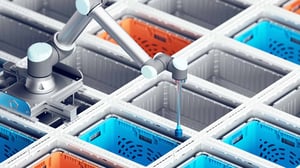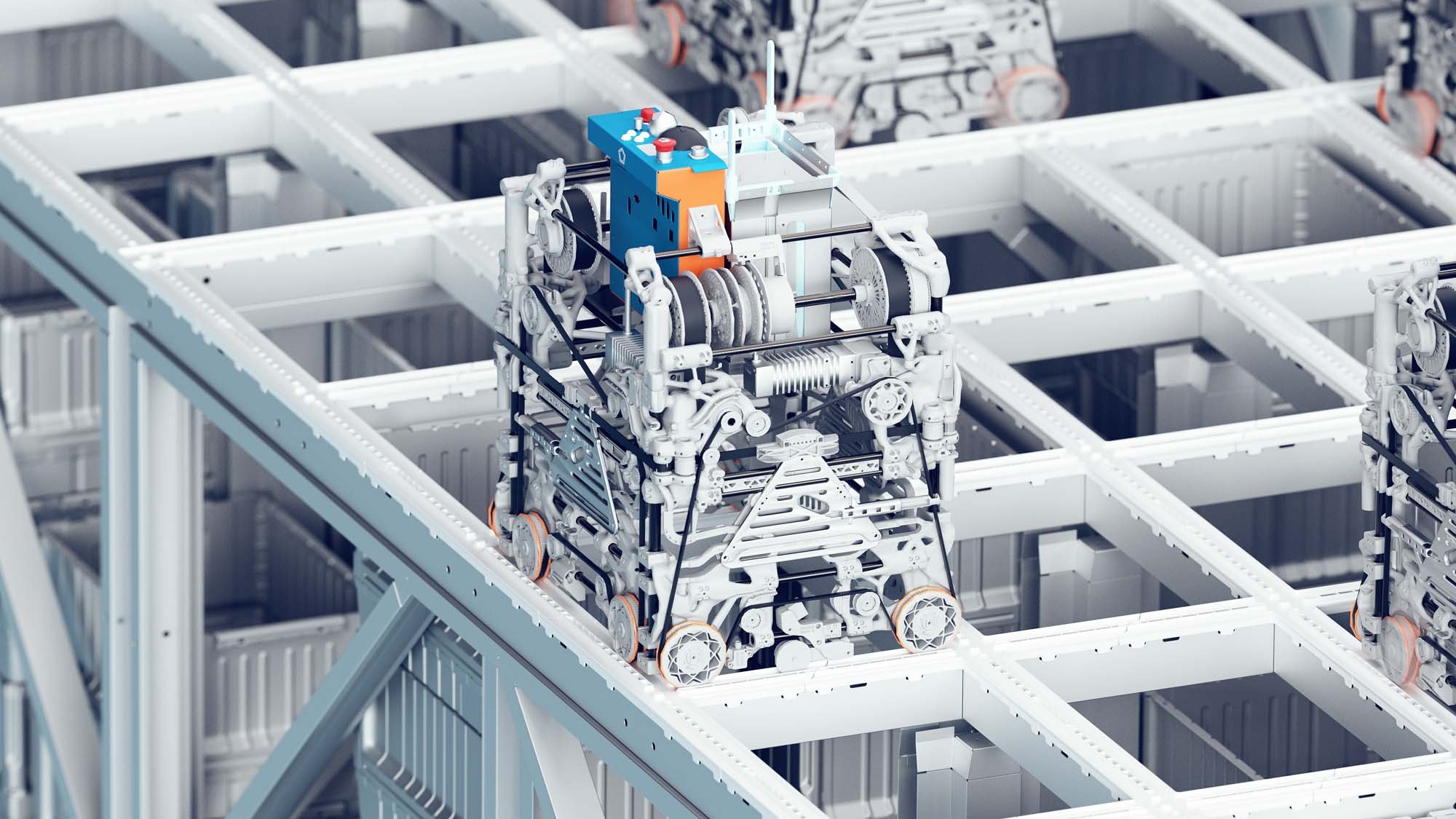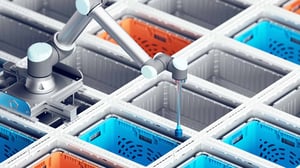
Glossary
Essential terms and concepts related to Ocado Intelligent Automation (OIA) and its products, including OSRS (Ocado Storage and Retrieval System) and Chuck AMR (Autonomous Mobile Robot).
3PL
3PL stands for Third Party Logistics and refers to companies which specialize in providing outsourced logistics and distribution services to businesses. Services typically include transportation, warehousing, inventory management, order fulfillment, and freight forwarding.
Advanced Sensing
Advanced sensing refers to the use of sophisticated technologies and techniques to gather, analyze, and interpret diverse environmental data with high accuracy, enhancing decision-making processes. Our robotic pick product uses advanced sensing to manipulate SKUs directly on the grid.
API
APIs, or application programming interfaces, act as intermediaries that allow two software systems to communicate with each other. OSRS requires integration with customers' business systems via APIs to facilitate seamless data exchange and synchronization. This ensures that OSRS can efficiently interact with existing warehouse management systems, order processing software, and other business applications, enabling streamlined operations and accurate information flow throughout the supply chain.
Automated Storage and Retrieval System (ASRS)
Automated Storage and Retrieval Systems (ASRS, sometimes AS/RS) are computer-controlled systems used for efficiently storing and retrieving goods and materials in a high-density storage configuration. The Ocado Storage and Retrieval System (OSRS) is an ASRS system.
Autonomous Mobile Robot (AMR)
An Autonomous Mobile Robot (AMR) is a robotic automation solution used for material transportation and handling, particularly within warehouse settings. These robots operate autonomously, utilizing sensors and onboard computing systems that enable them to perceive their surroundings, plan efficient routes, and operate without continuous human intervention. Chuck is our AMR product.
Automated Guided Vehicle (AGV)
An Automated Guided Vehicle (AGV) is a robotic automation solution that navigates predefined paths within a warehouse, transporting goods or materials between various locations. Unlike an AMR which uses sensors to navigate its environment, AGVs typically follow magnetic strips, wires, or markers on the floor.
Battery Swap
Battery swap is a high-capacity, automated device designed to facilitate the rapid exchange and charging of batteries for OSRS robots. Stations automatically remove a low-charged battery from a robot and replace it with a fully charged one, allowing for virtually uninterrupted service and maximum robot uptime. Supporting up to 100 robots per station, they are critical components of the OSRS system, maintaining high levels of robot utilization by minimizing downtime associated with battery charging.
Bin
A bin, often called a tote in Europe, is a storage container used to store items within a warehouse. The majority of bins on the market are made of polypropolyene. OIA's metal bins are unique to the market, providing enhanced protection from fire.
Bin Containment
Bin containment refers to the stacking of bins within a cubic ASRS grid for maximum cubic storage density and security.
Bin Digging
Bin digging refers to the process of robots moving bins out of the way in order to reach stock lower down in the grid. Minimizing bin digging results in greater throughput, as robots do not need to spend time digging down. OSRS' smart putaway algorithms constantly optimize stock within the grid to minimize bin digging.
Bin Lift
Bin lifts are mechanical devices used to move storage bins vertically between different levels within a storage system.
Bin Presentation
Bin presentation refers to the process of retrieving bins from within the grid and delivering them to workstations for picking.
Bot
A shortening of the word 'robot'. In the context of OIA, the robots that move stock within OSRS and Chuck AMR are often referred to as 'bots'.
Brownfield
"Brownfield" sites are existing sites (such as warehouses) with potential for redevelopment. This is opposed to greenfield.
Buffering
The term buffering refers to temporary storage between processes. In OSRS, buffering refers to returning completed orders to the grid prior to dispatch.
Cell
A cell refers to a specific location within the grid where inventory or completed orders are stored in bins. Each cell is assigned a unique identifier based on its X and Y coordinates, and it is accessible by robots.
Chuck AMR
Chuck AMR is an Autonomous Mobile Robot (AMR) developed by 6 River Systems, now part of OIA. Chucks are currently in operation worldwide helping customers to putaway, pick, sort and packout orders.
Components
Components are individual elements or parts of an overall system that are integral to the functioning and completeness of that system. In warehouse technology, components refers to the hardware and software which makes up our OSRS and Chuck AMR offerings.
Computer Vision
Computer vision, also called machine vision, is a subset of artificial intelligence (AI) focusing on enabling computers to capture and interpret visual information. A robot employing computer vision may use one or more smart cameras, radar or lidar sensors to avoid collisions and learn how to manipulate objects and its environment.
Conveyor System
Conveyor systems refer to the network of conveyor belts used to transport items, be it stock or waste packaging, throughout a warehouse.
Cubic Storage
Cubic storage refers to a storage configuration where inventory is stored in individual bins arranged in a three-dimensional grid structure. Each bin occupies a specific space or 'cell' within the storage system, which can be stacked to maximize vertical space utilization. This layout optimizes storage capacity within a given warehouse footprint, allowing warehouses to efficiently store a large volume of inventory while minimizing required floor space. The cubic storage design facilitates automated picking and packing processes, supporting efficient inventory management.
Delivery Asset
Delivery assets are the packaging materials used to transport orders during the last mile of delivery. They can be delivery totes, containers, boxes, polybags etc. Outbound orders are picked into these delivery assets at pick workstations. Once orders are ready for dispatch, delivery assets are sent for outbound delivery.
Delivery Tote
Within OSRS, delivery totes are dedicated containers stored within grid bins. Outbound orders are picked into these delivery totes at pick workstations. Once orders are ready for dispatch, the delivery totes are separated from the bins and sent for outbound delivery.
Digital Twin (Technology)
Digital twins are virtual representations of systems, processes, and products that mimic real-world behavior and characteristics in real-time, using data from sensors and devices. OIA uses digital twins to replicate and simulate various aspects of operations. This enables the optimization of operations and mitigates risks associated with complex installations by allowing virtual testing of new concepts, scenarios, and design configurations before physical implementation.
Downtime
Downtime refers to periods when automated systems or products are not operational. This may be due to site closure, routine maintenance or malfunction/repair. It is a critical performance metric that OSRS minimizes through advanced software algorithms (for example, smart putaway) and battery swap technology.
End Effector
An end effector is the device or tool connected to the end of a robotic arm, designed to interact with the environment and perform specific tasks such as picking, placing, gripping, or manipulating items. The end effector is a crucial component of OIA's robotic pick product, responsible for directly handling items from storage bins.
Fulfillment
Fulfillment is the complete process of executing customer orders, from the moment an order is placed until it is delivered. Warehouse operations is one key part of fulfillment.
Fulfillment Execution Software (FES)
OIA FES is a best-in-class fulfillment execution system for our Chuck AMR solution. It optimizes and prioritizes work to maximize productivity at the lowest operational cost using system-directed workflows. The cloud-based orchestration layer coordinates software and hardware based on a customer's open pool of work.
Goods-to-Person (GTP)
Goods-to-person (GTP) describes a method of warehouse fulfillment where items are brought directly to operatives at a workstation for picking by automated systems. OSRS is a GTP system. In contrast, Person-to-goods (PTG) involves operatives being led to goods stored in fixed locations. Chuck AMR is a PTG system.
Greenfield
Greenfield sites are undeveloped areas that have not been previously built upon. Greenfield developments require more extensive infrastructure and utilities to be installed from scratch compared to brownfield sites—however, they provide a greater opportunity for more complex or bespoke design.
Grid
The grid in ASRS is a three-dimensional framework of storage locations where items or products are stored. Robots are used to store and retrieve items from the grid. This design allows ASRS systems to maximize storage density by stacking items vertically and organizing them in a systematic order that facilitates automated retrieval and replenishment processes.
Grocery
The grocery industry encompasses organizations involved in the retail and distribution of food and household goods to customers. To learn more about our history in online fulfillment of grocery goods and Ocado Group's existing partnerships with grocery retailers worldwide, please visit www.ocadogroup.com.
Healthcare
The healthcare industry involves a broad spectrum of organizations and professionals dedicated to the provision and distribution of medical services, products, and care. Warehousing plays a crucial role in this industry, from temperature-controlled storage of medical supplies to automated ordering and prioritization by date code.
Intelligent Automation
Intelligent automation refers to a comprehensive approach to automating existing systems through the use of advanced technologies including AI, robotics, and software algorithms for increased efficiency, availability and accuracy while reducing human intervention.
Induct Station
Induct Stations are human-operated loading conveyors used to decant individual items or cases from inbound pallets in a warehouse into bins. Before entering the grid, bins at Induct Stations are weighed and scanned to ensure traceability and accuracy.
Inventory
Inventory within a warehouse refers to the stock of goods or materials carried by a merchant or distributor.
Inventory Management
Inventory management within the OSRS system involves strategic planning, monitoring, and control of inventory. It ensures efficient storage, accurate tracking, and timely fulfillment of orders within the automated warehouse environment.
Inventory Tracking
Inventory tracking refers to the process of monitoring and recording the movement, location, and status of inventory items within a warehouse.
Logistics
Logistics refers to the process of planning, implementing, and controlling the flow of goods, materials, and information from the point of origin to the point of consumption. It includes fulfillment, though covers the technical and logistical aspects of moving and managing goods throughout a supply chain.
Machine Learning
Machine learning, a subset of artificial intelligence (AI), develops algorithms enabling computers to learn from data to make predictions or decisions. Our robotic pick product employs machine learning to identify, handle new items, and adaptively improve picking and packing capabilities.
Maintenance
In the context of warehouse automation, maintenance refers to the proactive and reactive actions taken to ensure the optimal performance, reliability, and longevity of automated systems and equipment.
Material Handling Equipment (MHE)
Material handling equipment encompasses a wide range of activities, equipment, and systems involved in the movement, storage, control, and protection of goods and materials throughout various stages of the fulfillment process.
Mezzanine
Mezzanines are platforms or intermediary levels constructed within the warehouse space to provide additional floor area for observation, maintenance and repairs.
Mobile Fulfilment App (MFA)
Our Mobile Fulfillment App lets you manage and track Chuck AMRs (autonomous mobile robots) as well as non AMR order picking through third-party equipment.
Modular Design
Modular design refers to the use of standardized, interchangeable components or units that can be easily configured, combined, or expanded to create customized storage and retrieval solutions tailored to the specific needs of a customer. By leveraging standardized and interchangeable components, the modular design of our OSRS and Chuck AMR offerings allow for additional robots and workstations to be added with zero downtime, and the grid to be expanded as you grow.
Order Line
An order line represents a specific item or SKU included in a customer order, and it is processed, picked, packed, and shipped individually as part of the overall order fulfillment process.
Order Picking
Order picking refers to the selection, retrieval, and verification of items from within a warehouse to fulfill customer orders.
Ocado Storage and Retrieval System (OSRS)
The Ocado Storage and Retrieval System (OSRS) is an ultra-high-density cubic storage and retrieval system combining world-proven automation with business intelligence. The OSRS is built up of a variety of components including the grid, robots, bins, workstations, and warehouse execution system (WES) software. Together, these simplify and streamline complex challenges facing today's supply chains.
Packout
Packout refers to the process of packing picked items into shipping containers or boxes, preparing them for delivery to customers. This process is often the final step in the order fulfillment cycle, ensuring that items are securely and correctly packaged for shipping.
Palletizing
Palletizing is the process of arranging and stacking goods onto pallets in a organized manner for storage, transportation, and/or shipping purposes. Palletizing enables companies to maximize stability, space and load integrity while handling larger volumes of goods with minimal labor and resources.
Person-to-Goods (PTG)
A person-to-goods (PTG) system refers to a logistics setup where warehouse workers move to different storage locations to pick or replenish items. Chuck AMR is a PTG autonomous mobile robot solution that can be used to improve putaway, picking, sorting and returns tasks. This system is contrasted with goods-to-person (GTP) systems, where items are brought to the workers by automated systems, such as conveyors, robotic shuttles, or automated storage and retrieval systems such as the OSRS.
Pick Station
The workstation (or access point) at which a human picker manually moves products from a storage bin into a delivery tote/asset, based on prompts from the graphical user interface (GUI). In OSRS, pick stations can buffer totes/assets into the grid for temporary storage or can direct delivery assets to outload for immediate delivery.
Pick-to-Light (PTL)
Pick-to-light (PTL) is a technology used in warehouse and order fulfillment operations to improve the accuracy and efficiency of the picking process. In our pick-to-light systems, lights are installed at each picking location on our pick stations and illuminate to indicate to the picker where items need to be placed for accurate order fulfillment. PTL indicators provide real time visibility and reduce operator training time for a more engaged operator experience.
Pick Tunnel
A pick tunnel is a passageway within the OSRS grid structure that enhances order picking efficiency, ergonomics, and space utilization. By allowing access to items from within the storage structure, pick tunnels reduce robot travel time and streamline picking processes, making them valuable for high throughput customer needs.
Predictive Maintenance
Predictive maintenance involves monitoring of multiple sensors within a device or structure to detect signs of abnormal operation and take corrective action before something fails. We use predictive maintenance to maximize robot uptime by spotting failures before they happen.
Putaway
Putaway refers to the process of moving inventory or returned goods from the receiving area to their designated storage locations within the warehouse. OSRS employs smart putaway algorithms to determine the likelihood of an item being picked again soon, placing it in the most suitable space in the grid. Chuck AMR also makes returns putaway less strenuous by directing associates through the most efficient routes, replacing cumbersome push carts and improving worker safety.
Racking
Racking within a warehouse is the structural framework of shelves or racks used to store goods.
Reinforcement Learning
Reinforcement learning is a subset of artificial intelligence (AI) that focuses on a computer repeating a process and learning to improve the outcome via trial and error. In the context of our robotic pick product, reinforcement learning is employed to enable the system to autonomously make decisions about how to pick and pack items more effectively, learning from its experience and adaptive decision making. This over time lends to more efficient, accurate and adaptive warehouse operations.
Replenishment
Replenishment refers to the process of resupplying inventory to storage locations or customer brick and mortar sites, to maintain adequate stock levels for order fulfillment and operational efficiency.
Robot
Robots refer to our lightweight, high-speed helpers that traverse the top of the grid, performing the time-consuming job of fetching and dropping off bins with inventory, whether to human-assist pick stations or our fully automated robotic pick stations.
Robotic Pick
Robotic pick is an on-grid robotic arm, equipped with cutting-edge machine vision, deep reinforcement learning and advanced sensing, to pick and pack items without any prior knowledge of what they are.
Sequencing
Sequencing refers to the process of determining the optimal order in which items are stored, retrieved, batched or put away within the system. Our WES software sequences retrieval and putaway tasks intelligently, to optimize throughput, minimize cycle times, and adapt to dynamic operational conditions to meet the evolving needs of the supply chain.
Services
Services refer to the range of support, maintenance, and assistance we provide to ensure the optimal performance, reliability, and efficiency of our OSRS and AMR technology, drawing on over 20 years of experience operating our own facilities. Our service offerings are designed to address the needs of customers regarding systems integration, support and maintenance, design and implementation and customer success.
Stock Keeping Unit (SKU)
Stock Keeping Units are unique alphanumeric codes or identifiers assigned to each distinct item in a customer's inventory. SKUs are used to track and manage inventory levels, facilitate stock control, and streamline the ordering and fulfillment processes.
Storage Density
Storage density refers to the amount of inventory that can be stored in a given volume of space, typically measured in cubic feet or cubic meters. It is a critical metric in cubic ASRS because maximizing storage density within a given warehouse footprint enables more stock to be stored, and therefore provides greater opportunity for revenue.
System Availability
System availability refers to the proportion of time that an automation system is fully operational and capable of performing its intended functions without any interruptions or downtime. It is a critical performance metric that measures the reliability and efficiency.
System-directed Picking
System-directed picking refers to the process in which a control system directs workers or robots to pick items from specific locations in the warehouse. It starts with intelligent work assignment. Chuck AMR uses cloud-based algorithms to optimize and allocate work, grouping similar tasks to reduce associate travel. OIA FES uses real-time data to determine the optimal moment for a picker to switch from one Chuck to another. This enables associates to spend more time picking products and less time walking from one place to another.
Throughput
Throughput refers to the speed at which orders can be processed through a system within a given timeframe.
Universal Terminal
The Chuck AMR Universal Terminal is a display which offers a consistent user experience (UX) for all workflows. Executing our mobile sort software, it provides an engaging, step-by-step sortation experience making it simple for any associate to perform tasks with little training required.
Uptime
Uptime is a critical performance metric referring to the duration of time during which the system is fully operational and available for performing its intended functions without any interruptions or "downtime".
User Interface (UI)
A user interface (UI) is the means by which a human interacts with a computer system. It encompasses all visual and interactive elements that users interact with, including graphical user interface (GUI). GUIs serve as the primary means of interaction between warehouse personnel and automated warehouse systems, with the GUI guiding users through each step of a workflow.
Warehouse Automation
Warehouse automation refers to the integration of technology and automated systems to streamline and optimize the processes involved in the storage, retrieval, and movement of goods within a warehouse or distribution center.
Warehouse Efficiency
Warehouse efficiency refers to the overall effectiveness and productivity of warehouse operations, encompassing several key performance metrics and operational aspects. Efficient warehouse operations may involve maximizing space utilization and throughput, minimizing operational costs and ensuring high accuracy and reliability in order fulfillment/replenishment.
Warehouse Execution System (WES)
WES, also sometimes referred to as a Warehouse Control System (WCS), is the software application that orchestrates all robot movements within an ASRS. It takes pre-processed order data and creates a plan to fulfill and dispatch the orders at the required time given the number of robots, workstations and stock available in the grid.
Warehouse Management System (WMS)
A Warehouse Management System (WMS) is a software application designed to manage and optimize all aspects of warehouse operation, including labor, orders, shipments and warehouse processes. The WES is sometimes considered to be part of the WMS, focused on robot orchestration.
Warehouse Safety
Warehouse safety involves the implementation of measures to ensure the safe operation of automated systems and the protection of workers, equipment, and inventory within the warehouse environment.
Warehouse Slotting
Warehouse slotting refers to the strategic placement and organization of inventory within a storage solution to optimize the efficiency and effectiveness of warehouse operations. In OSRS, smart putaway algorithms work to ensure that items are stored in locations that maximize retrieval speed, minimize travel time and bin digs, and enhance overall productivity.
Workstations
Workstations are the points within a storage system at which stock is presented to a human operator for picking, packing and onward processing, or where stock is manually inducted into the system.
Zone Picking
Zone picking, also known as pick and pass, is a fundamental technique utilized in warehouses for order fulfillment. This method involves segmenting the warehouse into specific areas or zones, with each zone having its own dedicated picker. Within an OIA warehouse, zones can be covered by a human or AMR. FES uses real time task, associate and robot proximity and availability data to enable ever shifting work zones to maximize operational efficiency and productivity beyond that of typical fixed zones.
@4x.png?width=642&height=166&name=OIA_Logomark_color_(R)@4x.png)




